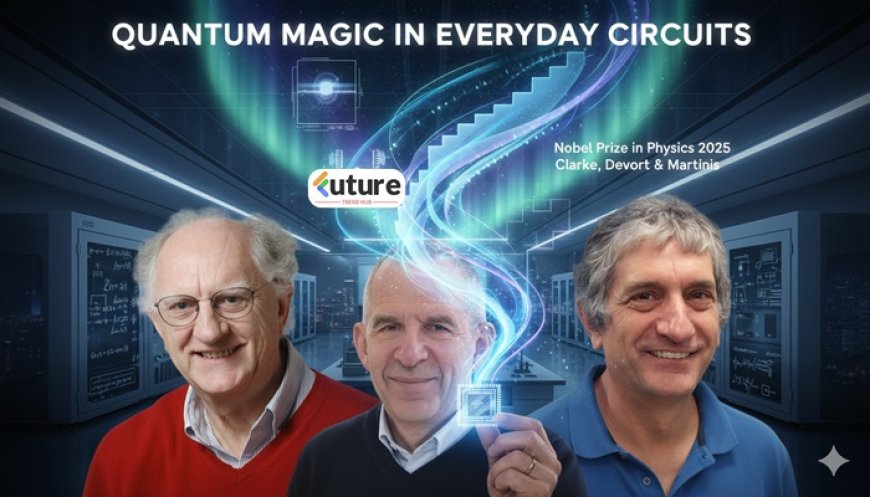Nobel Prize in Physics 2025: Clarke, Devoret & Martinis Reveal Quantum Magic in Everyday Circuits
Discover how John Clarke, Michel H. Devoret, and John M. Martinis transformed quantum theory into reality by demonstrating macroscopic quantum tunneling in electric circuits, earning the 2025 Nobel Prize in Physics.

From Superconductors to Supercomputers: The 2025 Nobel Physics Prize Unveiled
In a groundbreaking revelation, the Royal Swedish Academy of Sciences has awarded the 2025 Nobel Prize in Physics to John Clarke, Michel H. Devoret, and John M. Martinis for their pioneering work in demonstrating macroscopic quantum mechanical tunneling and energy quantization in electric circuits. This accolade honors their transformative experiments that brought quantum physics from the abstract into the tangible world of everyday electronics.
🔬 The Eureka Moment: Quantum Mechanics on a Chip
Imagine holding a piece of technology no larger than a fingernail, yet within it, the peculiarities of quantum mechanics unfold. In the 1980s, Clarke, Devoret, and Martinis embarked on a mission to observe quantum phenomena on a macroscopic scale. Their experiments centered around superconducting circuits, specifically using Josephson junctions—tiny, superconducting devices that allowed them to manipulate and measure quantum states.
Their breakthrough was nothing short of revolutionary. They demonstrated that these circuits could exhibit quantum mechanical behaviors, such as tunneling and discrete energy levels, at a scale visible to the naked eye. This was a significant departure from the norm, as quantum effects were traditionally confined to the microscopic realm.
⚡ What Is Macroscopic Quantum Tunneling?
At the heart of their discovery lies the concept of quantum tunneling. In classical physics, particles are expected to overcome energy barriers to move from one point to another. However, quantum mechanics introduces a twist: particles can 'tunnel' through these barriers, appearing on the other side without having traversed the intervening space.
Clarke, Devoret, and Martinis demonstrated that, under certain conditions, superconducting circuits could allow for this tunneling effect on a macroscopic scale. This was achieved by creating a system where a large number of Cooper pairs (pairs of electrons with opposite spins and momentum) could collectively exhibit quantum behavior, effectively turning a portion of the circuit into a single quantum system.
💡 Energy Quantization: The Digital Nature of the Quantum World
Another pivotal aspect of their work was the observation of energy quantization in these circuits. Just as electrons in atoms occupy discrete energy levels, the superconducting circuits they studied exhibited similar quantization. By applying microwave radiation, they could induce transitions between these energy levels, akin to the way atoms absorb and emit light.
This quantization is fundamental to the operation of quantum computers, where information is processed using quantum bits, or qubits, that exist in multiple states simultaneously. The work of Clarke, Devoret, and Martinis laid the groundwork for the development of such quantum systems.
🧩 From Lab Bench to Quantum Leap
While their initial experiments were driven by curiosity and a desire to understand the fundamental principles of physics, the implications of their findings have been profound. The ability to observe and manipulate quantum states in macroscopic systems has opened new avenues in technology.
Their work has directly influenced the development of quantum computing, where superconducting qubits are now a leading platform. Moreover, their discoveries have applications in quantum sensors and quantum cryptography, fields poised to revolutionize industries ranging from healthcare to cybersecurity.
🌍 A Legacy of Innovation
The 2025 Nobel Prize in Physics not only recognizes the individual achievements of Clarke, Devoret, and Martinis but also underscores the importance of collaborative research and the pursuit of knowledge. Their journey from theoretical concepts to practical applications exemplifies the essence of scientific discovery.
As we stand on the cusp of a new era in technology, the legacy of their work serves as a reminder of the power of curiosity and the endless possibilities that lie at the intersection of science and innovation.
Reference: https://www.nobelprize.org/prizes/physics/2025/press-release/







